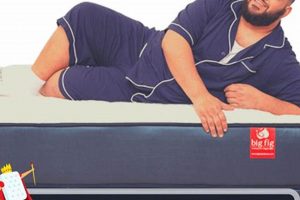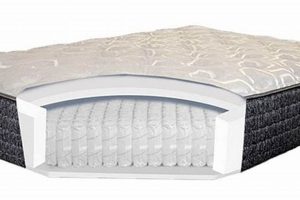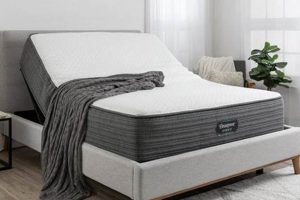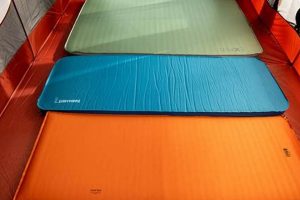The selection of a suitable sleeping surface for a vertical storage bed frame represents a critical aspect of space optimization and sleep quality. This involves identifying a mattress that provides adequate support and comfort while adhering to the specific size and weight restrictions inherent in the wall bed mechanism. The chosen mattress must be flexible enough to accommodate the folding and unfolding actions of the bed frame without sustaining damage or compromising its structural integrity. An example of a compatible option might be a low-profile memory foam mattress with reinforced edges designed for frequent use.
Prioritizing the appropriate mattress for a concealed bed unit ensures long-term functionality of the bed mechanism and promotes restorative sleep. Historically, wall beds presented limitations in mattress selection due to space constraints and mechanical requirements. Modern advancements in mattress technology, including the development of lighter and more flexible materials, have expanded the range of viable options. The correct mattress can transform a space-saving solution into a comfortable and inviting sleep environment, contributing to improved overall well-being.
Therefore, a thorough evaluation of various mattress types, considering factors such as thickness, weight, material composition, and support structure, is essential. The following sections will delve into specific mattress characteristics, performance metrics, and practical considerations to assist in making an informed decision regarding mattress selection for wall bed systems.
Essential Considerations for Choosing a Mattress
Selecting a mattress for a vertical storage bed necessitates careful evaluation to ensure both comfort and compatibility with the bed’s folding mechanism. The following tips offer guidance in this process.
Tip 1: Prioritize Weight Limitations: The weight of the mattress is a critical factor. Exceeding the manufacturer’s specified weight limit for the wall bed mechanism can compromise its functionality and safety. Consult the bed’s documentation for maximum weight allowance.
Tip 2: Assess Thickness Constraints: Wall beds typically accommodate mattresses of specific thicknesses. Opting for a mattress that is too thick can prevent the bed from closing properly, while a mattress that is too thin may lack sufficient support. Measure the available space within the frame before making a purchase.
Tip 3: Evaluate Mattress Material: Certain materials, such as latex or memory foam, offer greater flexibility and resilience than traditional innerspring mattresses. These materials are better suited to withstand the repeated folding and unfolding motions of a wall bed.
Tip 4: Consider Edge Support: Adequate edge support is essential for maximizing the usable sleep surface. Mattresses with reinforced edges prevent sagging and provide a more consistent level of support across the entire surface.
Tip 5: Explore Hybrid Options: Hybrid mattresses, combining elements of innerspring and foam construction, can offer a balance of support and comfort. However, careful attention should be paid to the overall weight and thickness of the hybrid mattress.
Tip 6: Inspect Mattress Flexibility: Prior to installation, assess the mattress’s flexibility by attempting to gently bend it. A mattress that is too rigid may not be suitable for a wall bed. Avoid excessively bending the mattress, as this could cause damage.
Tip 7: Review Warranty Information: Carefully review the mattress warranty to understand the terms and conditions related to use with a wall bed. Some manufacturers may void the warranty if the mattress is used in a manner inconsistent with its intended purpose.
Adhering to these guidelines when selecting a mattress ensures long-term functionality of the wall bed and promotes restful sleep.
The following sections will explore specific mattress types and their suitability for wall bed applications in greater detail.
1. Weight Limitation
Weight limitation is a critical factor in identifying a suitable mattress for a wall bed. The structural integrity and operational efficiency of the wall bed mechanism are directly dependent on adherence to the manufacturer’s specified weight constraints. Exceeding the prescribed weight can induce undue stress on the lifting mechanism, potentially resulting in premature wear, component failure, or even hazardous operational conditions. As such, determining the maximum weight capacity of the wall bed frame is the initial and arguably most important step in the selection process. For example, a spring-assisted lift mechanism designed for a maximum mattress weight of 50 lbs will likely experience accelerated fatigue or outright failure if consistently subjected to a 70 lb mattress.
The consequences of disregarding weight limitations extend beyond mere mechanical issues. Overloading a wall bed mechanism can create safety hazards, particularly during the opening and closing phases. A mechanism struggling to support excessive weight may exhibit jerky movements, unexpected slippage, or complete collapse, posing a risk of injury to the user. Furthermore, the type of mattress material directly correlates with its weight. Dense materials such as memory foam or latex, while often providing superior comfort, can contribute significantly to the overall mattress weight. In contrast, lighter alternatives like low-density foam or air mattresses may offer a more weight-conscious solution, albeit possibly at the expense of comfort and support.
In summary, understanding and respecting the weight limitations of a wall bed is essential for ensuring both its long-term functionality and the safety of its users. Proper mattress selection, therefore, necessitates a thorough assessment of the wall bed’s weight capacity and a careful evaluation of the weight characteristics of potential mattress candidates. Failure to prioritize this aspect can lead to costly repairs, compromised safety, and a diminished user experience, highlighting the critical link between weight limitation and the suitability of a mattress for use in a wall bed application.
2. Thickness Compatibility
Thickness compatibility represents a crucial parameter in determining the ideal mattress for a wall bed system. The mechanism of a wall bed is engineered to accommodate a mattress within a specific thickness range; exceeding this range inhibits proper closure of the unit, placing undue stress on the frame and potentially causing damage to both the bed and surrounding structures. Conversely, a mattress that is too thin may fail to provide adequate support, leading to discomfort and potentially compromising the intended sleeping posture. This relationship between mattress thickness and wall bed functionality underscores the need for precise measurements and adherence to manufacturer specificat
ions. For instance, a wall bed designed for an 11-inch thick mattress will likely experience closure difficulties with a 13-inch mattress, while a 7-inch mattress may result in an unsupportive and uncomfortable sleeping experience.
The consequences of disregarding thickness compatibility extend beyond mere operational inconvenience. A mattress that is too thick can exert constant pressure on the locking mechanisms of the wall bed, accelerating wear and tear and potentially leading to premature failure. This can necessitate costly repairs or even replacement of the entire unit. Moreover, forcing the closure of a wall bed with an incompatible mattress can damage the surrounding cabinetry or wall structure, incurring additional repair expenses. On the other hand, a mattress that is too thin can create gaps within the bed frame, posing a safety hazard for children or pets who may become trapped. Furthermore, inadequate support can contribute to back pain, poor sleep quality, and long-term musculoskeletal issues.
In conclusion, thickness compatibility is not merely a superficial consideration but a fundamental element in ensuring the proper function, safety, and comfort of a wall bed system. Prioritizing accurate measurements and adhering to manufacturer recommendations regarding mattress thickness is essential for maximizing the lifespan of the wall bed and optimizing the sleeping experience. Failure to do so can result in operational problems, safety hazards, and compromised sleep quality, highlighting the direct and significant impact of thickness compatibility on the overall suitability of a mattress for a wall bed application.
3. Flexibility
Flexibility, in the context of selecting the best mattress for wall bed, is a crucial attribute directly impacting the longevity and functionality of both the mattress and the bed mechanism. The repetitive folding and unfolding actions inherent to wall bed operation impose cyclical stress on the mattress. A lack of flexibility increases the risk of material fatigue, leading to premature sagging, cracking, or delamination of the mattress components. This, in turn, reduces the support provided, diminishes sleep quality, and necessitates more frequent mattress replacements. Consider a traditional innerspring mattress with tightly coiled springs; its limited flexibility makes it susceptible to deformation over time when repeatedly folded, unlike a memory foam or latex mattress designed to withstand such stress.
The selection of a mattress with inadequate flexibility can also negatively affect the wall bed’s mechanical components. A rigid mattress resists the closing action of the bed frame, potentially straining the hinges, latches, and supporting structures. This added stress can accelerate wear and tear, leading to malfunctions or even structural failure of the bed frame. For instance, a wall bed designed with a piston-assist mechanism may experience premature failure of the pistons if forced to overcome the resistance of an inflexible mattress. The impact extends beyond the immediate mechanical components, potentially affecting the surrounding wall and floor structures due to the increased forces involved in operation.
In summation, flexibility is not merely a desirable trait but a critical performance characteristic for a mattress intended for wall bed use. Choosing a mattress with sufficient flexibility mitigates the risks of material degradation, mechanical strain, and structural damage, ensuring both long-term comfort and sustained functionality of the wall bed system. By prioritizing this attribute, users can optimize their investment and avoid the costly consequences associated with selecting an incompatible mattress option.
4. Support Type
Support type constitutes a foundational element when determining the most suitable mattress for a wall bed application. The chosen support system directly influences spinal alignment, pressure point relief, and overall sleep quality. In the context of wall beds, the constraints of space and the mechanics of the folding mechanism amplify the significance of selecting an appropriate support type. Innerspring mattresses, for example, may offer robust support but often lack the flexibility required for repeated folding, potentially leading to spring damage and reduced lifespan. Conversely, memory foam mattresses conform closely to the body, providing excellent pressure relief, but may exhibit excessive compression when folded, compromising long-term support. The practical implication is that a hybrid mattress, combining the benefits of both innerspring and foam technologies while mitigating their respective drawbacks, may represent a superior choice for wall bed systems. A real-life example would be a wall bed owner experiencing back pain due to an unsupportive innerspring mattress that has deformed after repeated folding, highlighting the direct consequence of an inadequate support type.
Further analysis reveals that the density and composition of the support material play a crucial role in maintaining consistent performance over time. High-density memory foam, for instance, resists compression more effectively than lower-density alternatives, preserving its support characteristics even after repeated folding. Similarly, pocketed coil systems in hybrid mattresses offer independent support and minimize motion transfer, enhancing sleep quality. The practical application of this understanding is evident in the selection of mattresses for high-traffic wall bed installations, such as guest rooms or vacation rentals, where durability and consistent support are paramount. Investing in a mattress with a robust support system, tailored to the unique demands of a wall bed, minimizes the risk of premature wear and ensures a comfortable sleeping experience for users.
In conclusion, the connection between support type and mattress suitability for a wall bed is undeniable. A thoughtful selection process, considering factors such as material density, coil configuration, and overall flexibility, is essential for optimizing spinal alignment, pressure relief, and mattress longevity. While challenges may arise in balancing competing priorities, such as cost and material availability, prioritizing the appropriate support type remains a critical determinant of overall satisfaction with a wall bed system. The lack of attention to this critical aspect may ultimately result in a costly and uncomfortable compromise.
5. Material Durability
Material durability directly influences the suitability of a mattress for a wall bed system. The repeated folding and unfolding inherent in wall bed operation creates stresses that can compromise the structural integrity of less durable mattresses. Consequently, mattresses constructed from inferior materials may exhibit premature sagging, compression, or even tearing. This degradation not only diminishes comfort and support but also reduces the mattress’s lifespan, leading to more frequent replacements and increased costs. For example, a low-density foam mattress used in a frequently operated wall bed might exhibit significant compression within a year, whereas a high-density latex mattress could maintain its form and support for several years under similar conditions.
Further consideration reveals that material durabil
ity extends beyond resistance to compression and tearing. The mattress’s ability to withstand temperature fluctuations and humidity also plays a crucial role in its long-term performance within a wall bed. Some materials, such as certain synthetic foams, may become brittle or prone to mold growth when exposed to varying environmental conditions, further reducing their lifespan. The type of fabric used for the mattress cover also contributes to overall durability. A robust, tightly woven fabric can protect the inner materials from wear and tear, while a flimsy or loosely woven fabric may quickly deteriorate. In a real-world scenario, a vacation rental using wall beds might find that mattresses with durable, waterproof covers and high-density foam cores maintain their quality significantly better than those with less robust materials, reducing maintenance costs and improving guest satisfaction.
In summary, material durability is not merely an aesthetic consideration but a fundamental requirement for a mattress intended for use in a wall bed. Selecting a mattress constructed from high-quality, resilient materials ensures long-term comfort, consistent support, and reduced maintenance costs. While the initial investment in a more durable mattress may be higher, the extended lifespan and enhanced performance offer significant benefits over time, emphasizing the practical significance of material durability in the context of finding the most suitable mattress for wall bed systems.
Frequently Asked Questions
The following section addresses common inquiries regarding the selection of a suitable mattress for use in conjunction with wall bed systems.
Question 1: What are the primary considerations when selecting a mattress for a wall bed?
Key factors include weight, thickness, flexibility, support type, and material durability. The selected mattress must adhere to the wall bed’s weight and thickness limitations while providing adequate support and withstanding the stresses of repeated folding and unfolding.
Question 2: How does mattress weight impact the functionality of a wall bed?
Exceeding the manufacturer’s specified weight limit for the wall bed mechanism can compromise its functionality and safety. The mechanism may experience premature wear, component failure, or hazardous operational conditions.
Question 3: Why is mattress thickness a critical factor for wall beds?
A mattress that is too thick can prevent the bed from closing properly, placing undue stress on the frame. Conversely, a mattress that is too thin may lack sufficient support, leading to discomfort. It is important to stay within the bedframe’s recommended parameters.
Question 4: What role does flexibility play in mattress selection for wall beds?
The repeated folding and unfolding of a wall bed imposes cyclical stress on the mattress. A lack of flexibility increases the risk of material fatigue, leading to premature sagging or cracking. Spring or hybrid are not suggested.
Question 5: Which mattress materials are best suited for wall beds?
Materials like latex and memory foam offer greater flexibility and resilience than traditional innerspring mattresses. These materials are better suited to withstand the repeated folding and unfolding motions of a wall bed. The foam density is also important to consider.
Question 6: Are there specific warranty considerations when using a mattress with a wall bed?
Carefully review the mattress warranty to understand the terms and conditions related to use with a wall bed. Some manufacturers may void the warranty if the mattress is used in a manner inconsistent with its intended purpose.
Prioritizing these considerations ensures the selection of a compatible and durable mattress, maximizing the lifespan and functionality of the wall bed system.
The subsequent sections will delve into specific mattress models and brands commonly recommended for wall bed applications.
Concluding Remarks on Mattress Selection
The preceding analysis underscores the critical importance of careful consideration when selecting a mattress for a wall bed. Factors such as weight, thickness, flexibility, support, and material durability directly influence the lifespan and performance of both the mattress and the wall bed mechanism. Prioritizing these characteristics is essential for maximizing the return on investment and ensuring user safety and comfort.
Failure to account for these considerations can result in costly repairs, compromised functionality, and a diminished sleeping experience. Therefore, thorough research and adherence to manufacturer specifications are paramount. By making informed choices, consumers can optimize their wall bed systems and enjoy years of reliable and comfortable use. The long-term benefits of such diligence significantly outweigh the risks associated with neglecting the outlined parameters. Further investigation into specific mattress models, coupled with professional consultation, is encouraged to facilitate optimal decision-making.


![Top: Best Rated Latex Mattress [Reviews & Guide] Organic & Natural Mattress Buyer’s Guide: Non-Toxic Sleep Solutions Top: Best Rated Latex Mattress [Reviews & Guide] | Organic & Natural Mattress Buyer’s Guide: Non-Toxic Sleep Solutions](https://mattressworldpa.com/wp-content/uploads/2025/07/th-7593-300x200.jpg)



![Ultimate Guide: Best Mattress Latex [2024 Review] Organic & Natural Mattress Buyer’s Guide: Non-Toxic Sleep Solutions Ultimate Guide: Best Mattress Latex [2024 Review] | Organic & Natural Mattress Buyer’s Guide: Non-Toxic Sleep Solutions](https://mattressworldpa.com/wp-content/uploads/2025/07/th-7589-300x200.jpg)
